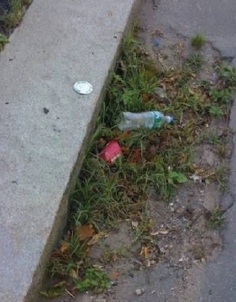Vegetation Control for Safety
by Airton Kohls; Source: Vegetation Control for Safety - FHWA
The warmest months of the year bring thriving vegetation working to retake ownership of our roads that once belonged to mother nature. With that comes the critical job of vegetation control, so important for improving the safety of all users of our beautiful Tennessee transportation system. Vegetation can be a hazard. Grass, weeds, brush and tree limbs can obscure or limit a driverís view of traffic control devices, approaching vehicles, pedestrians and bicycles. Controlling vegetation helps reduce crashes and injuries. The Federal Highway Administration (FHWA) provides very relevant information on the Vegetation Control for Safety guide with the purpose of helping local road agency maintenance workers identify locations where vegetation control is needed, providing guidance to maintenance crews and making them aware of safe ways to mow, cut brush and otherwise control roadside vegetation. Roadway agencies are encouraged to develop roadside vegetation management programs to define the best maintenance practices for each location. An integrated roadside vegetation management program consists of eliminating or controlling vegetation through a variety of strategies including mowing, brush cutting (mechanical and hand), use of herbicides, grazing of livestock, cultivating desirable vegetation, and re-vegetation.
Goals of Vegetation Control
The main goals of vegetation control include:
- Keeping signs visible to drivers.
- Keeping road users (vehicles, bicycles and pedestrians) visible to drivers.
- Improving visibility of livestock and wildlife near the road.
- Helping pedestrians and bicyclists see motor vehicles.
- Keeping sidewalks and pedestrian paths clear and free from overhanging vegetation.
- Removing trees close to the roadway which could result in a severe crash if hit.
- Helping drainage systems function as designed.
- Preserving pavements through daylighting and root system control.
- Controlling noxious weeds in accordance with local laws and ordinances.

Specific Things to Check
Sign VisibilitySigns should be visible to drivers at all times. Maintenance patrols should be on the lookout for trees and brush that block the view of signs and other traffic control devices. Tree branches or rush in front of a sign can hide it from view of motorists. Right-of-way control signs (STOP and YIELD signs) are most critical; brush and tree branches in front of them should be cut immediately. It is important that motorist see warning and guide signs as well, so blocking vegetation in front of these signs should be trimmed as soon as possible.

Tall grass, weeds and brush in the shoulder, ditch and backslope areas of a roadside can create problems. Low fixed object hazards such as culvert headwalls, drainage inlets, guardrail ends and any object markers in front of them can be hidden by tall grass. High grass can also obscure the shoulder. Shoulder and roadside maintenance such as grading or mowing should be done to define the edge of shoulder and ditch so that motorists can see the shape, condition, and limits of the roadside.

On the inside of horizontal curves, vegetation growth close to the edge of pavement can block a driver's view of motor vehicles (in the same or opposite direction), bicycles and pedestrians. Maintaining roadsides so headlights and taillights can be seen around the inside of horizontal curves can increase the horizontal sight distance available.
DrainageWeeds, turf and sod can interfere with roadside drainage. A high shoulder creates a secondary ditch and damages the pavement. Water on the pavement due to high shoulders creates safety problems, including hydroplaning. Grading may be necessary to make sure the shoulder continues the road crown smoothly.

Side Road Visibility
Roadway intersections increase the chances of vehicle crashes. Safe and efficient vehicle movement through an intersection requires good visibility. As drivers approach an intersection, they need to check each quadrant of the intersection for the presence of entering vehicles. Similarly, drivers pulling out from a STOP sign need a clear view of oncoming traffic. A clear vision triangle at each corner of an intersection helps drivers avoid problems.
Visibility is a particular concern at rail-highway grade crossings due to the severe crashes that can occur. Brush and trees should not be allowed to obscure the railroad tracks and any approaching trains. A cooperative effort of the railroad and roadway agency is needed. Municipalities are responsible for controlling the vegetation on their right-of-way and railroads are responsible for controlling the vegetation on their right-of-way. Due to the size of the sight triangles at grade crossings, private property owners may also need to participate in vegetation control.

To learn more about Vegetation Control for Safety go to: http://safety.fhwa.dot.gov/local_rural/training/fhwasa07018/vegetationfv1108.pdf
Back-Contents-Forward